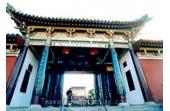The Memorial Temple Of Lord Bao
- Things to do
-
- Photo(10)
- Tips&article(4)
- Make it Happen
- Map
-
loading...
The full name of this temple is the Memorial Temple of Lord Bao Xiaoshu. It was constructed in memory of Bao Zheng who is idealized as an upright and honest official and a political reformer in the Song Dynasty. Xiaoshu is Lord Bao's posthumous name that was granted by Emperor Renzhong of the Song Dynasty in order to promote Lord Bao's contribution to the country.
The Temple consists of a central building with two wings attached perpendicularly. In the central building, Lord Bao Hall, there is a huge statue of Lord Bao. He is portrayed as sitting on a chair and holding a sceptre in one hand and a pen in the other. The austere and stern expression on his face displays his impartial and incorruptible moral character.
To the west of Lord Bao Hall are a long walkway and a small pavilion along the river that is called Liufang Pavilion. To the east is Dragon Well Pavilion, with an ancient well called Lian Spring in it. The well is also called Dragon Well because several dragons are carved on the roof of the pavilion, and they are reflected in the well in the daytime. If the water ripples, it looks like the dragons are flying. The well received its name from an article written by Li Guowei, a Juren of the late Qing Dynasty, called: “Jin Xiang Ji."He wrote:“The water in the well beside the Memorial Temple of Lord Bao is magic; corrupt officials will get a headache when drinking it."
The Temple is surrounded by water, and its main entrance faces south. In its west gallery are exhibited The Book of Bao Genealogy, artefacts, Family Instructions and some relevant books. The Temple is surrounded by the Baohe River in which it is said that the Honghua lotus grew. In the temple area, there is a waxworks display that portrays Lord Bao stories and the Cultural Corridor of Lord Bao. They are great sight-seeing exhibits for visitors to understand the story of Lord Bao.
Tips & articles
|
|
|
forum discussion
|










